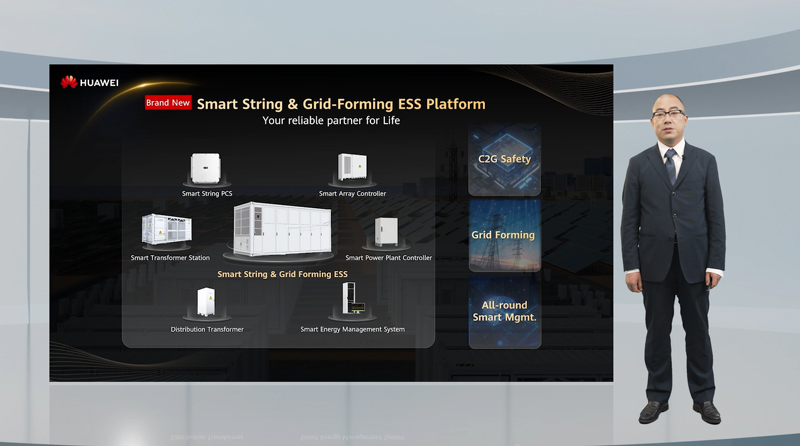[Munich, Germany, 18 June, 2024] Intersolar Europe is about to open grandly, Huawei FusionSolar held the Intersolar New Launch Live to global customers, to showcase the latest R&D innovation results.

Steve Zheng, President of Utility Smart ESS Business, Huawei Digital Power, launched the brand new Cell-to-Grid Smart String & Grid-Forming ESS Platform. The platform consists of the Smart String ESS, Smart String PCS, Smart Transformer Station, Smart Array Controller, Smart Power Plant Controller, and Smart Energy Management System. It is compatible with large-capacity lithium iron phosphate cells of different specifications, provides flexible capacity, and can be used in scenarios of any C-rate to reduce the LCOE throughout its lifetime.
Since 2013, Huawei has chosen string inverter technology. In 2020, Huawei launched the industry's first string ESS, which uses controllable power electronics technologies to resolve the inconsistency and uncertainty of lithium batteries. After years of application and verification, Huawei has updated its energy storage products and developed key capabilities in safety, grid forming, intelligence, and efficiency. The brand new Smart String & Grid-Forming ESS Platform features full-architecture safety, all-scenario grid forming, full-lifecycle cost-effectiveness, and full-link digitalization. Moreover, the platform is built upon an open ecosystem and designed to foster the high-quality and healthy development of power plants throughout the lifecycle with partners.
Four key indicators can be used to measure initial configuration of an ESS: round-trip efficiency, constant power discharge range, availability, and SOC precision. Huawei Smart String & Grid-Forming ESS uses a unique intelligent cooling system, which reduces the auxiliary loss by 50% and achieves 90.3% round-trip efficiency (including auxiliary efficiency) on the PCS output. In addition, the pack optimization features 2.0 can balance battery packs in real time. The rack management architecture ensures that batteries discharge energy at a constant power regardless of the SOC. In terms of availability, Huawei Smart String & Grid-Forming ESS achieves 99.9% availability thanks to refined management, modular design, and the minimal use of vulnerable parts. Together, they ensure more accurate discharge with an SOC precision of less than 3%. To sum up, Huawei provides comprehensive performance assurance. The initial configuration of the Smart String & Grid-Forming ESS can be reduced to meet the same performance requirements.
It is worth mentioning that one of the cutting-edge advantages of the Smart String & Grid-Forming ESS Platform lies in its grid forming capability, which is essential to improving the grid integration and consumption of renewable energy. As predicted for a project in Qinghai, China, when the short circuit ratio (SCR) is 1.5, the Smart String & Grid-Forming ESS can increase the renewable energy output by 40%.
Energy storage is a flexible resource that is crucial to power generation, transmission, distribution, and consumption of new power systems. Equipped with the grid forming capability, an ESS will provide reliable support for new power systems. Huawei will continuously carry out empirical tests in various scenarios and modes with a broad range of specifications to provide better solutions and create greater value for customers.

 Search
Search




 Search
Search


